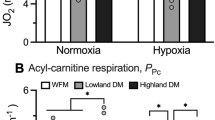Summary
The effects of different ambient temperatures (T a) on gas exchange and ventilation in deer mice (Peromyscus maniculatus) were determined after acclimation to low and high altitude (340 and 3,800 m).
At both low and high altitude, oxygen consumption (\(\dot V_{O_2 }\)) decreased with increasingT a atT a from −10 to 30 °C. The\(\dot V_{O_2 }\) was 15–20% smaller at high altitude than at low altitude atT a below 30 °C.
Increased\(\dot V_{O_2 }\) atT a below thermoneutrality was supported by increased minute volume (\(\dot V{\text{I}}\)) at both low and high altitude. At mostT a, the change in\(\dot V{\text{I}}\) was primarily a function of changing respiration frequency (f); relatively little change occurred in tidal volume (V T) or oxygen extraction efficiency (O2EE). AtT a=0 °C and below at high altitude,\(\dot V{\text{I}}\) was constant due to decliningV T and O2EE increased in order to maintain high\(\dot V_{O_2 }\).
At high altitude,\(\dot V{\text{I}}\) (BTP) was 30–40% higher at a givenT a than at low altitude, except atT a below 10 °C. The increased\(\dot V{\text{I}}\) at high altitude was due primarily to a proportional increase inf, which attained mean values of 450–500 breaths/min atT a below 0 °C. The\(\dot V{\text{I}}\) (STP) was equivalent at high and low altitude atT a of 10 °C and above. At lowerT a,\(\dot V{\text{I}}\) (STPD) was larger at low altitude.
At both altitudes, respiratory heat loss was a small fraction (<10%) of metabolic heat production, except at highT a (20–30 °C).
Similar content being viewed by others
Abbreviations
- EHL :
-
evaporative heat loss
- f :
-
respiration frequency
- HL a :
-
heat loss from warming tidal air
- HL e :
-
evaporative heat loss in tidal air
- HL :
-
total respiratory heat loss
- MHP :
-
metabolic heat production
- O 2 EE :
-
oxygen extraction efficiency
- RQ :
-
respiratory quotient
- T a :
-
ambient temperature
- T b :
-
body temperatureT lc lower critical temperature
- \(\dot V_{O_2 }\) :
-
carbon dioxide production
- \(\dot m_{{\text{H}}_{\text{2}} {\text{O}}}\) :
-
evaporative water loss
- \(\dot V_{O_2 }\) :
-
oxygen consumption
- \(\dot V{\text{I}}\) :
-
minute volume
- V T :
-
tidal volume
References
Bernstein MH, Schmidt-Nielsen K (1974) Ventilation and oxygen extraction in the crow. Respir Physiol 21:393–401
Brent R, Pedersen P, Bech C, Johansen K (1984) Lung ventilation and temperature regulation in the European cootFulica atra. Physiol Zool 57:19–25
Bouverot P, Hildwein G, Oulhen P (1976) Ventilatory and circulatory O2 convection at 4,000 m in pigeons at neutral or cold temperature. Respir Physiol 28:371–385
Bucher TL (1981) Oxygen consumption, ventilation and respiratory heat loss in a parrot,Bolborhynchus lineola, in relation to ambient temperature. J Comp Physiol 142:479–488
Casey TM, Withers PC, Casey KK (1979) Metabolic and respiratory responses of Arctic mammals to ambient temperature during the summer. Comp Biochem Physiol 64A:331–341
Chappell MA (1984) Maximum oxygen consumption during exercise and cold exposure in deer mice,Peromyscus maniculatus. Respir Physiol 55:367–377
Chappell MA, Holsclaw DS (1984) Effects of wind on thermoregulation and energy balance, in deer mice (Peromyscus maniculatus). J Comp Physiol B 154:619–625
Chappell MA, Snyder LRG (1984) Biochemical and physiological correlates of deer mouse alpha-chain hemoglobin polymorphisms. Proc Natl Acad Sci USA 81:5484–5488
Colacino JM, Hector DH, Schmidt-Nielsen KK (1977) Respiratory responses of ducks to simulated altitude. Respir Physiol 29:265–281
Conley KE, Porter WP (1983) Seasonal shift in thermoregulatory ability of the deer mouse,Peromyscus maniculatus. Am Zool 23:936
Epstein MAF, Epstein RA (1978) A theoretical analysis of the barometric method for measurement of tidal volume. Respir Physiol 32:105–120
Frisancho AR (1975) Functional adaptation to high altitude hypoxia. Science 187:313–319
Hargrove JL, Gessaman JA (1973) An evaluation of respiratory rate as an indirect monitor of free-living metabolism. In: Gessaman JA (ed) Ecological energetics of homeotherms. Utah State University Press, pp 77–86
Hill RW (1983) Thermal physiology and energetics ofPeromyscus: ontogeny, body temperature, metabolism, insulation, and microclimatology. J Mammal 64:19–37
Lenfant C (1973) High altitude adaptation in mammals. Am Zool 13:447–456
Malan A (1973) Ventilation measured by body plethysmography in hibernating mammals and poikilotherms. Respir Physiol 17:32–44
Schmidt-Nielsen K, Hainsworth FR, Murrish DE (1970) Counter-current heat exchange in the respiratory passages: effect on water and heat balance. Respir Physiol 9:263–276
Stahl WR (1967) Scaling of respiratory variables in mammals. J Appl Physiol 22:453–460
Tracy CR, Welch WR, Porter WP (1980) Properties of air: a manual for use in biophysical ecology, 3d edn. University of Wisconsin, Madison
Welch WR (1984) Temperature and humidity of expired air: interspecific comparisons and significance for loss of respiratory heat and water from endotherms. Physiol Zool 57:366–376
Wickler SJ (1980) Maximal thermogenic capacity and body temperatures of white-footed mice (Peromyscus) in summer and winter. Physiol Zool 53:338–346
Withers PC (1977a) Metabolic, respiratory and haematological adjustments of the little pocket mouse to circadian torpor cycles. Respir Physiol 31:295–307
Withers PC (1977b) Respiration, metabolism, and heat exchange of euthermic and torpid poorwills and humming-birds. Physiol Zool 50:43–52
Withers PC, Casey TM, Casey KK (1979) Allometry of respiratory and haematological parameters of Arctic mammals. Comp Biochem Physiol 64A:343–350
Author information
Authors and Affiliations
Rights and permissions
About this article
Cite this article
Chappell, M.A. Effects of ambient temperature and altitude on ventilation and gas exchange in deer mice (Peromyscus maniculatus). J Comp Physiol B 155, 751–758 (1985). https://doi.org/10.1007/BF00694590
Accepted:
Issue Date:
DOI: https://doi.org/10.1007/BF00694590




